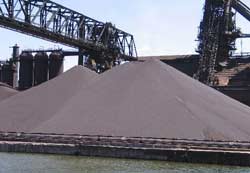|
Having failed in Australia, Rio Tinto and Chinalco plan to make up in Africa through a $12-billion joint venture to develop the Simandou iron ore project in Guinea.  The world' second largest miner, Rio Tinto and China's state-owned Aluminium Corporation of China (Chinalco) are considering a business venture after the Chinese industrial giant's $19.5-billion investment plan in Rio Tinto was torpedoed by the shareholders of the Anglo Australian miner last year, forcing the company to go in for a $15.2-billion rights issue to solve its debt problems. (See: Rio terminates Chinalco deal; to raise $15.2 billion through rights issue) The world' second largest miner, Rio Tinto and China's state-owned Aluminium Corporation of China (Chinalco) are considering a business venture after the Chinese industrial giant's $19.5-billion investment plan in Rio Tinto was torpedoed by the shareholders of the Anglo Australian miner last year, forcing the company to go in for a $15.2-billion rights issue to solve its debt problems. (See: Rio terminates Chinalco deal; to raise $15.2 billion through rights issue)
According to reports, both companies are in the final stage of negotiations to develop Rio Tinto's Simandou mining concession in the West African state of Guniea at a developmental cost of $12 billion. The deal is reported to be structured in such a way that Chinalco would invest the money to develop the project in exchange for a minority stake in it, with Rio Tinto as the major partner. Rio Tinto, which holds mining concession for 738-square km in Simandou in Guinea, had shelved plans to develop the project last year in the wake of the slump in commodity prices and aggressive cost cutting to reduce its $42-billion debt by $10 billion by the end of 2009. (See: Major shake up at Rio Tinto to reduce debt) Rio Tinto chief executive Tom Albanese had said in December 2008 that the Simandou project was "without doubt, the top undeveloped tier-one iron ore asset in the world" and had estimated the development cost at approximately $6 billion, which analysts now say is likely to be almost double that amount. The Simandou iron ore project is estimated to hold 2.25 billion tonnes of ore, and if developed, has the potential to become the world's third-largest mining area, after Australia's Pilbara and Brazil's Carajas. It also has the potential to generate approximately $10 billion in annual revenues from the very first year of operation. Since Simandou is located 750km from the sea with no rail links and infrastructure. Rio Tinto will have to spend about $6 billion only in building a railway line from the mine to the coast. According to analysts, Rio Tinto has tied with Chinalco, Rio's largest shareholder with an approximately 9.3-per cent stake, to develop the Simandou project, in order to get China to solve its part ownership problems at Simandou with the present military government in Guniea, where China has recently signed a $7-billion covert bauxite mining deal in exchange for infrastructure development without a tender being floated. In December 2008, the previous government of Guniea had terminated Rio's decade-old license for the northern part of the Simandou project since the company had not undertaken any drilling or exploration in that area. Rio Tinto had only been actively involved in drilling in the southern part of the Simandou project but had neither made any worthwhile investment nor drilled in the northern part. The government of Guniea decided to terminate the northern license immediately after Rio announced on 10 December 2008 that it would delay investment of more than $25 billion on 16 projects including the Simandou project as part of its aggressive cost cutting campaign.(See: Major shake up at Rio Tinto to reduce debt ) On 27 December 2008, the government of Guniea terminated Rio's northern license of Simandou and re-allocated and awarded the license to its lesser known rival, BSG Resources, a privately owned mining company owned by Israeli billionaire, Steinmetz under the so-called "use-it-or-lose-it" principle. (See: Guniea ousts Rio Tinto from ore project) Ahead of announcing the Rio-Chinalco deal, China released a report this week on its probe into Chinalco's failed $19.5-billion planned investment with Rio Tinto last year, which ruled that neither the Australian government nor the Rio Tinto Group were responsible for the failure of the deal going through. (See: China's report on failed Chinalco bid clears Australia, Rio, not BHP), instead pinning the blame squarely on Rio's former suitor BHP Billiton's aggresive backdoor manoeuvring Chinalco's vice-president, Lu Youging also gave an indication when he said this week that the company was looking at overseas deals in order to become an international multi-metals mining company. Chinalco is also reported to be talking with Rio to jointly develop the Oyu Tolgoi copper-gold project in Mongolia, where Rio Tinto has a joint venture with Canada's Ivanhoe Mines. Most probably this deal has already been structured since Rio Tinto hiked its stake this month in Ivanhoe Mines by 2.7 per cent to 22.4 per cent with the optionto further raise it to about 44 per cent by converting a $350-million loan into stock and exercising all its share purchase warrants. (See: Rio Tinto ups stake in Mongolian JV to 22.4 per cent) Tom Albanese is scheduled to visit Beijing in the weekend to address the China Development Forum, where the deal is likely to be announced.
|